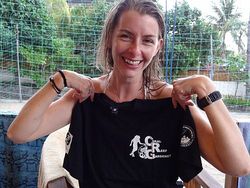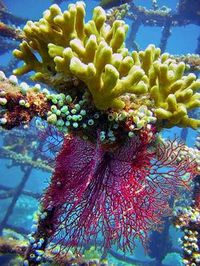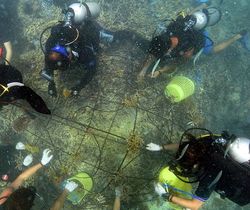Diving opens up a whole new underwater world of natures marvels – but it also reveals the damage humans do. Attending a Biorock® Reef Gardening Course offers a great way to help keep reefs healthy and prospering. By Fiona Childs.

A happy Fiona Childs shows off her Coral Gardening t-shirt issued by Gili Eco Trust
Gili Trawangan, 2 February 2012. There are places that draw you back again and again. For me one of these is the Gili Islands. They are breathtakingly beautiful with views of the mountains and volcanoes of Lombok and Bali. The lack of motor transport, relaxed pace of life and gorgeous beaches make them a wonderful place to spend a holiday, and of course, there is also the world under the sea.
It was here that I took my first underwater breaths, and where my passion for scuba diving began. Nothing beats the initial excitement of being surrounded by schools of fish, colourful coral and grazing turtles. However, over time divers become aware of the fragility of marine life. You start to notice corals broken by anchors or bleached from global warming, and rubbish littering the ocean floor.
As a result, I wanted to learn more about coral reefs and how to help conserve them. Having heard about the Biorock® technique of restoration, I was eager to sign up for the Training Workshop for Reef Restoration in 2010.

What was once a barren underwater desert now blooms with live coral, thriving on the Biorock framework - result!
Created by Professor Wolf Hilberz and Dr Thomas Goreau of the Global Coral Reef Alliance, Biorock is a simple yet amazing system. Structures are made from steel bar, placed underwater close to shore and connected to a low voltage electrical current. This promotes electrolysis which prevents rusting and leads to calcareous precipitation – in other words the steel bar collects a limestone covering which is stronger than concrete and the perfect place for coral to grow. Broken fragments of coral are attached to the steel bar, and some usually settle there naturally too. And they continue to grow – making a whole new reef.
Corals grow quickly on Biorock and soon the artificial structures provide habitats and nurseries for marine life, dive and snorkel sites. They have the added bonus of providing shelter by dispersing the impact of waves and preventing erosion of beaches.
Biorock® structures are not just functional; they can be works of art. Celia Gregory artist and founder of the Marine Foundation has been involved in designing many of the structures. There are a dolphin, manta ray, turtles and boats among others at Gili Trawangan. Her latest projects, the Coral Goddess at Pemuteran in Bali and Deus sculpted motorbike at Gili T are awe inspiring and bring awareness to a much wider audience. Both also use solar panels so are truly eco projects.

Made Astawa, a BIorock course participant, 'rides' the Deus bike underwater
I was very fortunate to be able to assist with attaching the anode and cables to the Deus Biorock®. It was an amazing experience to attach it to the power of the sun as grey clouds gathered, a storm began to break, yet undeterred people freedived down to pose for photos.

Once the framework was complete, it was manhandled into place by the team
The Reef Restoration course exceeded my expectations by far. To have the opportunity to learn from someone as experienced, knowledgeable and inspiring as Dr Tom Goreau should not be passed up! There were presentations from many speakers covering a wide range of topics from marine biology to climate change, physics and chemistry. The course brought together people from all over the world, from different backgrounds but all with a passion for preserving coral reefs.
One of my favourite recollections is watching the documentary on the Pemuteran Biorock® project on a big screen, lying on a beach under the stars. However, it was not all theory; we built many structures, went on many coral gathering dives and attached corals to their new homes. It was magical when fish came to investigate the new reef.
In December 2011 I returned to Gili Trawangan to attend the Gaia Discovery Reef Gardening & Restoration Programme with a group of divers from Living Seas in Singapore. This time the emphasis was more on coral gardening - maintaining the reefs through removing predators such as Drupella snails, harmful sponges and algae, and generally monitoring coral health. I was delighted to see the structures we built a year earlier flourishing. We also built a new star-shaped reef frame, which we christened as 'Living Star'. At the end of the course we received the PADI Biorock® Specialty certificate.

It was real, tough teamwork when it came to building the starfish frame.
We hear so much about environmental destruction that it’s easy to forget that there are many wonderful projects going on – like all the work done by the Gili Eco Trust. As well as the Biorock® projects they also promote recycling, hold regular beach clean ups, offer education in the local school, involve local dive shops, refill water bottles, hold horse clinics and other issues.
Attending the Biorock® courses has taught me so much. I am a much more aware diver and look at coral reefs with new appreciation - in fact I look forward to doing a spot of gardening on my next dives! If you want to get more out of your diving and give something back to the reefs that give us so much then I highly recommend it. Not only that, Gili Trawangan is a great place to socialise with beachside bars and restaurants and some wild parties too if you’re not diving in the morning!
Photos by Fiona Childs, Vintty Koloay and Mallika Naguran
Gili Eco Trust, Big Bubble Dive & Bungalows and Living Seas were partners of the Gaia Discovery Reef Gardening & Restoration Programme.